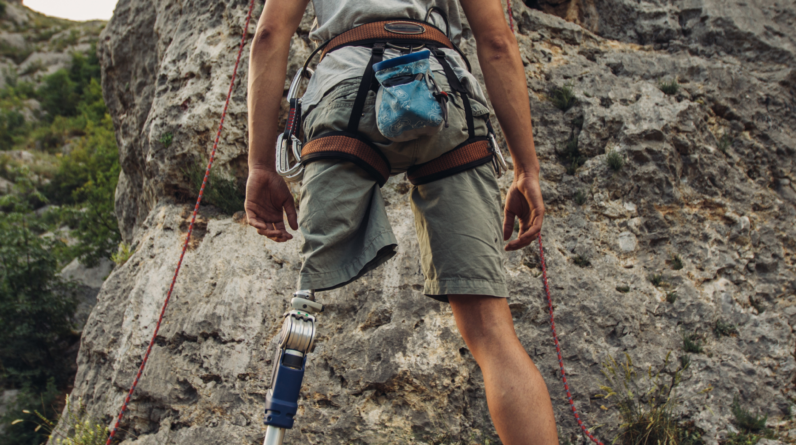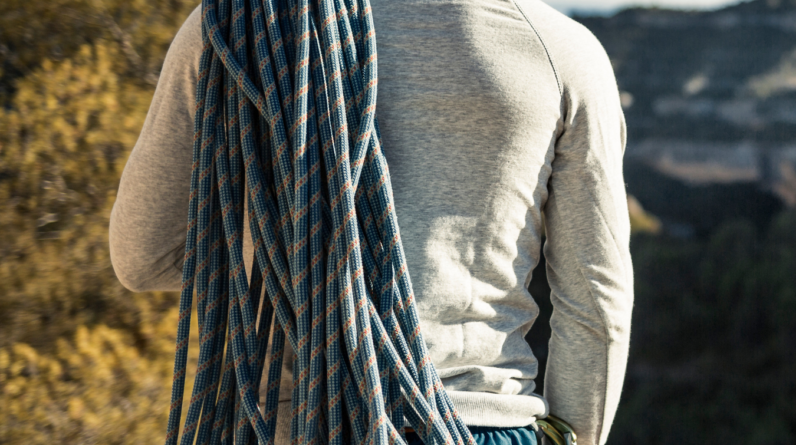
Rock Climbing Hands Care

Keeping your rock climbing hands healthy and happy requires a little care. There are a number of common problems a beginner climber can face, from dry skin to blisters. It is best to start small to prevent them.
One of the first steps in rock climbing hands care is to moisturize your hands before a session. The use of lotions can increase elasticity and decrease cracking. When you plan to climb outside, this is particularly important. Dry skin may cause blisters or tears and can even lead to splits.
Another step to rock climbing hands care is to trim your nails. Untrimmed nails are rough on the walls and can cause scratches. It is better to trim your nails than risk the nerves and discomfort that can come from catching a sharp edge.
The healing process will be accelerated if you use a hand soap. A salve that contains arnica oil will help you care for the joints in your fingers. Arnica oil is known for its ability to treat muscle pains and strains.
These are just a few of the other care tips that rock climbers should remember. You should not only hydrate your hands but also care for your joints and tendons. You can ease the pain caused by a muscle strain with cold water. You can prevent your blisters leaking by using a bandage. Some areas may need to be fixed with a little bit of climbing tape.
It is important that you moisturize your hands before you climb, and also to clean your hands after each session. You can remove any chalk, dirt and grime from your hands by doing this. It is best to avoid washing dishes with your wet hands. It is also a good idea to wash your hands after using the dishwasher. You should also use an antibacterial gel to clean your hands and prevent infection.
The right hand salve is a good way to hydrate your hands. Oily lotions can make hands slippery and wax-based creams may cause problems with your phone’s ability to work. Using a good hand salve is a great way to prevent dry skin and calluses from forming.
Calming your skin with a cold compress can help prevent calluses. Hot tubs should be avoided after climbing. While this may seem like an effective way to cool off, it can actually damage your skin. Your calluses may even begin to fall off if you soak your hands in warm water.
Avoid pawing on polished hold edges. This is another rock climbing tip. This may seem like a no-brainer, but pawing can actually contaminate the hold. To file the rock’s ridges, it is a smart idea to use a file made of sandpaper. This will prevent you from getting flappers.
Another rock climbing hands care tip is the use of the right type of chalk. The right type of chalk can not only keep your hands safe from slippage but also give you the best grip. It is also possible to use a chalk bag and a callus filer.
Rock Climbing Skin Care Tips

Keeping your hands in good shape is important for rock climbing. To keep your skin elastic and resilient to injury, you must moisturize it regularly. It is also important to keep your hands clean, since germs are spread when you handle rocks.
You should wash your hands after you have climbed. Using a hand salve is especially important for cuts or flappers. It will help moisturize the skin and speed up the healing process.
You can also use a hand file to smooth the skin on your hands. These tools are usually available in most gyms. You may also want to get a pair of nail clippers to remove dead skin. It will prevent any future soreness.
You may need to use climbing tape depending on what type of climb you’re doing. Tape is useful for protecting the lower thirds of your fingers by being used with sharp holds. It can also be used as a bandage to prevent a blister from forming. You should try to use less tape each time you climb, since too much tape can cause damage.
The epidermal layer of your skin is very important for climbing. It serves as a protective layer to keep dirt and germs from getting inside. Your hands will stay flexible and stretch with this layer. Climbing holds are rough and abrasive, which means your hands are likely to get dirty and damaged. It is essential to wash your hands often.
Calhouns, another form of natural skin protection that can be built up while climbing, are also available. Calluses can help protect your hands and make it easier for you to hold on. However, you should not file your calluses too much, as this can weaken them. You can use a sandpaper board or block to file down calluses that are more thick than your surrounding skin. A hand salve may be useful. Hydrogen Peroxide can be used to remove grease.
You can also take a break from climbing to help your hands recover. Winter is a time to care for your hands. You may be restricted by your schedule if you compete climb. Good nutrition can help reduce muscle inflammation. This will make climbing more enjoyable and less painful.
A hand salve is another great option for hands care when climbing. You will need to use it if you have a cut or flapper, but you can also use it to moisturize the skin. Avoid using a lotion that contains oil or wax as this could make your hands slippery. To prevent skin drying out, moisturizers are recommended for climbers who use it often.
If you find yourself with a blister or other tear, you should try to stop the tears immediately. You can use friction tape to cover the wound, which may help prevent new tears. You can also apply antibiotic ointment to the wound, and keep it clean. You can also take a full day off to heal the injury. This will allow your hands to heal more quickly, and you will have more time for climbing.
Rock Climbing Hands Care

Whether you’re a beginner or an expert climber, your hands need to be taken care of. Your hands get dirty and they carry germs, so it’s important to keep them clean. In addition to this, you’ll want to moisturize your hands regularly to keep them supple.
To keep your hands in top shape, make sure to wash them thoroughly after every climb. You can use a hand soap, or even some hydrogen peroxide to wash away grease. Afterwards, moisturize your hands with a moisturizing cream or lotion. Don’t use oily lotion or wax; they’ll make your hands slippery. Avoid hot water and don’t wash your hands. Heat can cause calluses to peel off.
You may also want to use a hand salve. This is especially helpful for flappers. It can help keep a blister clean and prevent it from becoming a ripper. You can speed up healing.
Another great idea is to take a cold compress. Cold compresses prevent the formation of calluses. It is possible to file calluses even if they are still damp. If you do this, be sure to remove the tape halfway through. It will protect your lower third of fingers. You can even purchase a special calluses filer.
You’ll also want to make sure that your nails are trimmed. If they’re not, they can catch on walls or other climbing holds. This can be very painful. If you’re climbing for a long time, you may even develop worn tips. This can be prevented by taking a day off.
You may also want to consider using chalk. You can also use chalk to prevent slippage and dry your hands. Liquid chalk is also an option. You can also use liquid chalk to help you sweat less and improve your grip. You can use this when climbing outside, or you can use it before a big route.
You should also use the best hand salve you can afford. It will heal your skin and help prevent the formation of calluses. This is also great for injured muscles. A good diet will also help your skin to heal.
If you have calluses, you’ll want to file them down to a reasonable size. This can be done with a pumice or nail file. You can also use a high-grit, sandpaperblock. It is important to not rub the callus too much. Exercising too hard can lead to callus rupture.
To keep dirt from sticking to your skin, you should wash your hands immediately after climbing. You shouldn’t take your climbing shoes with you to the toilet. You should also use hand soap and moisturize your hands after every climb. To moisturize your hands, you can use an oil-based cream. To prevent infection, you’ll need to clean your hands and keep them dry.
A plan is a great idea for handling any issues that might arise. You may need to remove any calluses that are still wet.
Climbing Skin Repair Tips

Climbing requires that you keep your skin healthy, hydrated and happy. Every person’s skin is different, so different minerals and rock types can be more difficult on certain skin types. You should make sure you know the best way to take care of your skin before you start climbing, and make sure to follow these tips when you climb.
There are many different types of skin repair products available to climbers. There are many options for skin repair products, including creams, lotions and balms. They are formulated to help you deal with different skin problems, such as abrasions, splits, and tears. Do your research to ensure you find the best product. EWG’s Skin Deep Cosmetic Database can help you find safe products for your skin.
Natural ingredients such as sweet almond oil and tea tree oil are good for climbing skin. They contain proven ingredients to speed up your skin’s healing. These products are less harmful than many commercial brands. There are also a number of other products that are specifically designed for climbers.
It is important to clean your skin before you go climbing. Before you climb, it is important that dirt and dust be removed from your skin. When you’re done climbing, rinse your skin with cold water. It will cool your skin and decrease the chance of getting burnt.
A good moisturizer is also important. A moisturiser is important because it helps to give your skin elasticity and make it soft. It will protect your skin against cracking and splitting. For best results, use a non-wax based moisturizer. You might also want to try an eczema cream, which is a product designed to moisturize dry, irritated skin. It is crucial to choose the best product for you skin, because the wrong one can make it worse.
Avoiding greasy food and other dehydrating foods is the best way to maintain healthy skin. Drink plenty of fluids throughout the day, particularly on hot days. Dehydrated skin is more likely to break out and tear.
To keep your skin healthy, it is essential to wash your hands regularly. Use a high-quality product to wash your hands. This will get rid of any grease or dirt. Also, avoid pawing on the polished edges of your projects. This can contaminate the hold you are climbing on.
A compound tincture with benzoin might also work well for treating damaged skin. You can make your tape stick more securely and your skin will be stronger.
Climbing skin repair products will vary depending on the type of rock you’re climbing on. You will need to research the right balm for your needs. There are many types of balms available.
Do You Need a Skin File For Climbing?

A skin file can be helpful for anyone who climbs, whether they are new or experienced. A file will help to remove dead skin from your fingers and give your skin a more smooth surface. You can also use a file to remove tiny bits of skin that can get stuck on your finger nails. Mammut’s Climskin file, for instance, has been ergonomically designed to help you keep your skin healthy. It is made from the highest quality length of curved wood, which allows you to file away calluses without having to worry about damaging your skin. It can be used with Climbskin hand cream, which provides additional warmth and elasticity to the skin.
If you’re not sure whether you need a skin file for climbing, it’s a good idea to monitor your calluses and check for tiny flake-like pieces. It’s also a good idea to keep them at the same level as the rest of your skin, since this can help prevent flappers.
To file your calluses down, you have two options: either use a nail filing tool or use a block of high-grit sandpaper to do it. You can also use a pumice stone to get rid of ridges or scratches on your finger tips. This will make your fingers more flexible and increase your climbing ability. As magnesium helps absorb waste, it’s best to get rid of calluses as soon as possible.
You can also use climbing tape, which can be used on both rough rock and sharp holds. If you want to avoid tearing your fingers while climbing, it’s a good idea not to do your handwork with your hands wet. You should also try to keep your nails neat and tidy, as this can prevent them from catching on the climbing holds or your clothing.
You can find many skin files available on the marketplace, however you need to choose one with the right grit for your climbing needs. Start with a high grit number, then go down in grit size as you become more experienced. To reduce calluses that are large, you may want to try a smaller grit. Avoid excessive moisture when you are removing calluses. This can soften your skin, which can slow the healing process.
The Climskin File from Mammut is an ergonomically designed tool that allows you to file away calluses without damaging your skin. This file has the best quality length of rounded wooden, so it can be used around your natural finger contours. It also comes with four extra replacement sandpapers for use with the Climbskin Hand Cream.
You can also use climbing tape to tape over your calluses. This can be especially useful when climbing on rough rock or sharp holds. You’ll also need to keep your fingers clean and dry, since chalk can dry out your skin and sap its natural oils.






